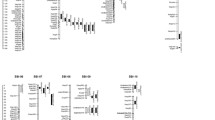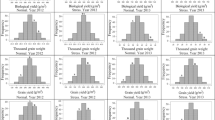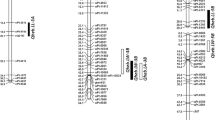Abstract
Stay green or delayed senescence is considered to play a crucial role in grain development in wheat when assimilates are limited. We identified three QTLs for stay green on the chromosomes 1AS, 3BS and 7DS using a recombinant inbred (RI) population developed by making crosses between the stay green parent ‘Chirya 3’ and non-stay green ‘Sonalika’. The RI lines were evaluated in natural field conditions for 2 years in replicated trial. The QTL on chromosome 1A was identified in both the years, while the QTLs on 3BS and 7DS were identified only in 1st and 2nd year, respectively. The QTLs explained up to 38.7% of phenotypic variation in a final simultaneous fit. The alleles for higher stay green values derived from the stay green parent ‘Chirya 3’. The QTLs were named as QSg.bhu-1A, QSg.bhu-3B and QSg.bhu-7D. The QTL QSg.bhu-3B and QSg.bhu-7D were placed in the 3BS9-0.57-0.78 and 7DS5-0.36-0.61 deletion bins, respectively.


Similar content being viewed by others
References
Benbella M, Paulson GM (1998) Efficacy of treatments for delaying senescence of wheat leaves: II. Senescence and grain yield under field conditions. Agron J 90:332–338
Börner A, Schumann E, Fürste A, Cöster H, Leithold B, Röder MS, Weber WE (2002) Mapping of quantitative trait loci determining agronomic important characters in hexaploid wheat (Triticum aestivum L.). Theor Appl Genet 105:921–936
Cha KW, Lee YJ, Koh HJ, Lee BM, Nam YW, Paek NC (2002) Isolation, characterization and mapping of stay green mutant in rice. Theor Appl Genet 104:526–532
Evangelista CC, Tangonan NG (1990) Reaction of 31 nonsenescent sorghum genotypes to stalk rot complex in Southern Philippines. Trop Pest Manag 36:214–215
Ganal MW, Röder MS (2007) Microsatellite and SNP markers in wheat breeding. In: Varshney RK, Tuberosa R (eds) Genomics-assisted crop improvement: vol. 2: genomics applications in crops. Springer, Netherlands, pp 1–24
Huang XQ, Kempf H, Ganal MW, Röder MS (2004) Advanced backcross QTL analysis in progenies derived from a cross between a German elite winter wheat variety and a synthetic wheat (Triticum aestivum L.). Theor Appl Genet 109:933–943
Jenner CF, Rathjen AJ (1975) Factors regulating the accumulation of starch in ripening wheat grain. Aust J Plant Physiol 2:311–322
Jiang GH, He YQ, Xu CG, Li XH, Zhang Q (2004) The genetic basis of stay-green in rice analyzed in a population of doubled haploid lines derived from an indica by japonica cross. Theor Appl Genet 108:688–698
Joshi AK (2003) Development of physiological approaches for breeding wheat varieties suited to different heat stress environment. Progress Report, NATP (ICAR) Project (P-2793), B.H.U., Varanasi, India
Joshi AK, Kumari M, Singh VP, Reddy CM, Kumar S, Rane J, Chand R (2007a) Stay green trait: variation, inheritance and its association with spot blotch resistance in spring wheat (Triticum aestivum L.). Euphytica 153:59–71
Joshi AK, Ortiz-Ferrara G, Crossa J, Singh G, Alvarado G, Bhatta MR, Duveiller E, Sharma RC, Pandit DB, Siddique AB, Das SY, Sharma RN, Chand R (2007b) Associations of environments in South Asia based on spot blotch disease of wheat caused by Cochliobolus sativus. Crop Sci 47:1071–1081
Karen H, Subudhi PK, Borrell A, Jordan D, Rosenow D, Nguyen H, Klein P, Klein R, Mullet J (2007) Sorghum stay green QTL individually reduce post-flowering drought-induced leaf senescence. J Exp Bot 58:327–338
Kumar U, Joshi AK, Kumar S, Chand R, Röder MS (2009) Mapping of resistance to spot blotch caused by Bipolaris sorokiniana in spring wheat. Theor Appl Genet 118:783–792
Kumar U, Joshi AK, Kumar S, Chand R, Röder MS (2010) Mapping of quantitative trait loci and identification of diagnostic markers for resistance to spot blotch caused by Bipolaris sorokiniana in wheat (T. aestivum L.) lines ‘Ning 8201’ and ‘Chirya 3’. Mol Breed. doi:10.1007/s11032-009-9388-2
Kumari M, Singh VP, Tripathi R, Joshi AK (2006) Variation for stay green trait and its association with canopy temperature depression and yield traits under terminal heat stress in wheat. In: Proceedings of the 7th international wheat conference, Mar del Plata, Argentina, 27 Nov–2nd Dec 2005
Lander ES, Green P, Abrahamson J, Barlow A, Daly MJ, Lincoln SE, Newburg L (1987) MAPMAKER: an interactive computer package for constructing primary genetic linkage maps of experimental and natural populations. Genomics 1:174–181
Marza F, Bai GH, Carver BF, Zhou WC (2006) Quantitative trait loci for yield and related traits in the wheat population Ning7840 × Clark. Theor Appl Genet 112:688–698
Park SY, Yu JW, Park JS, Li J, Yoo SC, Lee NY, Lee SK, Jeong SW, Seo HS, Koh HJ, Jeon JS, Park YI, Paek NC (2007) The senescence induced stay green protein regulates chlorophyll degradation. Plant Cell 19:1449–1464
Rawson HM, Hindmarsh JH, Fischer RA, Stockman YM (1983) Changes in leaf photosynthesis with plant ontogeny and relationships with yield per ear in wheat cultivars and 120 progeny. Aust J Plant Physiol 10:503–514
Reynolds MP, Nagarajan S, Razzaque MA, Ageeb OAA (2001) Breeding for adaptation to environmental factors: heat tolerance. In: Reynolds MP, Ortiz-Monasterio JI, McNab A (eds) Application of physiology in wheat breeding. CIMMYT, Mexico, DF, pp 124–135
Röder MS, Korzun V, Wendehake K, Plaschke J, Tixier M-H, Leroy P, Ganal MW (1998) A microsatellite map of wheat. Genetics 149:2007–2023
Roelfs AP, Singh RP, Saari EE (1992) Rust diseases of wheat: concepts and methods of disease management. CIMMYT, Mexico, pp 1–81
Silva SA, Carvallo FIF, Caetano VR, Oliveira AC, Coimbra JLM, Vasconcellos NJS, Lorencetti C (2000) Genetic basis of stay green trait. J New Seeds 2:55–68
Sourdille P, Singh S, Cadalen T, Brown-Guedira GL, Gay G, Qi L, Gill BS, Dufour P, Murigneux A, Bernard M (2004) Microsatellite based deletion bin system for the establishment of genetic-physical map relationships in wheat (Triticum aestivum L.). Funct Integr Genomics 4:12–25
Spano G, Di Fonzo N, Perrotta C, Platani C, Ronga G, Lawlor DW, Napier JA, Shewry PR (2003) Physiological characterization of ‘stay green’ mutants in durum wheat. J Exp Bot 54:1415–1420
Thomas H, Howarth CJ (2000) Five ways to stay green. J Exp Bot 51:329–337
Thomas H, Smart CM (1993) Crops that stay green. Ann Appl Biol 123:193–201
Thomas H, Ougham H, Canter P, Donnison I (2002) Wheat stay-green mutant tells us about nitrogen remobilization in leaf senescence. J Exp Bot 53(370):801–808
Thorne GN (1982) Distribution between parts of the main shoot and the tillers of photosynthate produced before and after anthesis in the top three leaves of the main shoot of Hobbit and Maris Huntsman winter wheat. Ann Appl Biol 101:553–559
van der Plank JE (1963) Plant disease: epidemics and control. Academic Press, New York
Wang S, Basten CJ, Zeng ZB (2007) Windows QTL cartographer 2.5. Department of Statistics, North Carolina State University, Raliegh. http://statgen.ncsu.edu/qtlcart/WQTLCart.htm
Wingler A, von Schaewen A, Leegood RC, Lea PJ, Quick WP (1998) Regulation of leaf senescence by cytokinin, sugars, and light. Plant Physiol 116:329–335
Zadoks JC, Chang TT, Konjak CF (1974) A decimal code for the growth stages of cereals. Weed Res 14:415–421
Acknowledgments
This research was supported by a DAAD-Leibniz (German Academic Exchange Service) fellowship to Uttam Kumar. Initial work on RILs was supported by the Council of Scientific and Industrial Research, New Delhi to Maya Kumari. Authors are thankful to Ram Awadh, Anette Heber and Sonja Allner for excellent technical assistance.
Author information
Authors and Affiliations
Corresponding author
Rights and permissions
About this article
Cite this article
Kumar, U., Joshi, A.K., Kumari, M. et al. Identification of QTLs for stay green trait in wheat (Triticum aestivum L.) in the ‘Chirya 3’ × ‘Sonalika’ population. Euphytica 174, 437–445 (2010). https://doi.org/10.1007/s10681-010-0155-6
Received:
Accepted:
Published:
Issue Date:
DOI: https://doi.org/10.1007/s10681-010-0155-6




